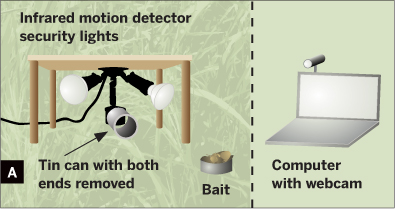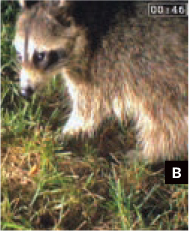
Photography by Bob Goldstein
ANIMAL DETECTOR
 A webcam captures animals who visit while you sleep.
A webcam captures animals who visit while you sleep.
My 4-year-old son comes up with some funny ideas. A few months ago, he asked for a piece of cheese to leave outside for animals. We gave him a slice of cheddar. The next morning he jumped out of bed and hurried to the window. The cheese was gone, but who had taken it? He was guessing all day. We looked for footprints or tiny hairs, but found no clues.
Then we got more ambitious. I knew that some webcam programs can record video only when there’s visible motion. That might record visitors in daylight, but not in the dark. So we got an inexpensive infrared-sensing floodlight — a standard home security device — at a hardware store. I figured that in theory, a warm animal moving in front of the device should make the light turn on, and then the webcam program would see movement and start recording.
That evening we tested it, with the webcam pointing out a window and the floodlight just outside. The next morning, my son and I raced to the laptop. A white cat had visited at 4:30 a.m., and the video caught it flinching as the light came on, looking quizzically at the contraption, and then starting to eat. My son was fascinated, and we were both hooked on our new hobby.
Lights, Webcam, Action!
Instead of a plug, most motion sensor lights have loose wires for connecting to house wiring. We wanted to plug ours in outside, so we drilled a hole in the plastic casing for a 2-wire plug cord, twisted the corresponding wires in each pair together, and insulated the connections with twist-on connector caps. Then we sealed the space between the cord and the hole with crazy glue.
MATERIALS
Motion detector floodlight We used a Cooper Regent MS35, $13.
Floodlight bulbs (2) $3 each
2-conductor cord with power plug about $5
Wood board, 12"×18"
Wood dowels, 1" diameter, 9" long (4)
Wood screws (4)
Empty tin can with ends removed
Computer We used a Mac laptop.
Webcam if the computer doesn’t have one built in
Motion detection software We used BTV Pro (bensoftware.com, $34, free 15-day trial). Other similar programs exist for both Mac and PC.
Duct tape
Cyanoacrylate glue aka super or crazy glue
Bait such as pet food or old fruit
PVC pipe (optional)
TOOLS
Power drill and drill bits
NOTE: I really don’t know what I’m doing playing with wires and electricity. Please take care to protect yourself appropriately.
The lights and motion sensor are designed to work outside, but rain dripping into the sockets can be a hazard. So we mounted the device under a protective platform built by simply screwing 4 wooden dowels into the corners of a board. We attached the motion sensor light underneath, following the included instructions. We also bought some PVC pipe to fit around the legs, to use as stilts if we ever want to raise the platform.
Motion sensors detect movement over a wide angle, so we duct-taped an empty tin can with both ends removed over the sensor (see Figure A). This serves as a blinder so that only animals right at the bait will make the light turn on.

Fig. A: The setup is very simple.
To capture video from inside the house, we used a Mac laptop and a webcam running BTV Pro. This Mac-only software has a motion detection setting, plus a nice option to show the time in the corner of the video image (Figure B).

Fig. B: Closeup of a nighttime visitor.
For bait, we’ve successfully used inexpensive cat food, old fruit, or scraps from dinner. Before we retire for the night, we just start up BTV Pro and put out the bait. Then it’s like the old Easy-Off oven cleaner ads: it works while you sleep!
Results
After our first night’s success, I thought we might just keep getting the same cat. But the diversity of animals we’ve captured on video has been amazing.
In our first month, we shot 9 species: raccoons, cats, 1 robin, 1 wren, 1 catbird, 1 sparrow, 1 squirrel, 1 rabbit, and 1 human — our neighbor’s son passing through our yard early one morning. And we’ve had possums come so regularly that we started putting out decorative backdrops for a laugh (Figure C).

Fig. C: Backgrounds added for comedic effect.
Illustrations by Alison Kendall
The entertainment payback for this easy and inexpensive project has been terrific. Setup takes just a few minutes each day, and an animal appears most nights. Some animals have given us quite a laugh, like a possum that walks slowly in reverse each time the light turns on, a young rabbit that appears to panic and run toward — instead of away from — the house, and a squirrel who’s learned to evade the motion sensor with a commando-style crawl.
Bob Goldstein is a dad who enjoys making stuff. His son wants to be an inventor when he grows up. Their videos can be seen at animaldetector.blogspot.com.
